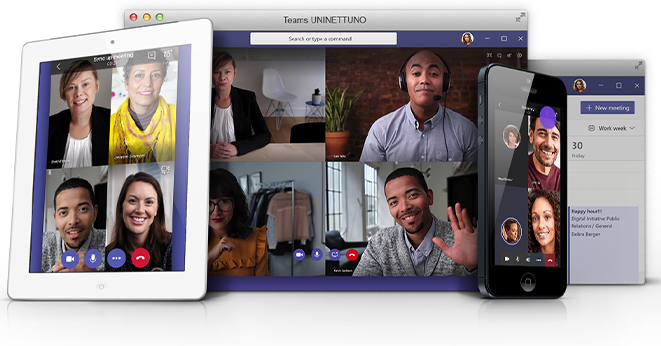The Interactive Classroom is a learning environment allowing for synchronic interactions between teachers and students with no space and time limits.
This environment allows the teacher to include and manage students in the Interactive Classroom, including minimum one student to 250 maximum. Of course, in order to have a constructive interactivity, UNINETTUNO’s educational model envisages that, in each session, there can be maximum 30 students.
Access modes
|
Teachers/Tutors |
Students |
-
Activate your UNINETTUNO-Microsoft account by opening the Options page (available on your Tutor’s Page) and clicking on Your account UNINETTUNO-Microsoft button
-
Download the Teams software from the Download page
-
Execute the login with your UNINETTUNO-Microsoft credentials
-
Tick the Checkbox "Keep the access" in order to not be forced to enter again username and password
-
Execute the first setup; in order to access the learning environment you will only need to click on the link to the conference which you will find in Agenda to any new meeting created by your Teacher/Tutor.
-
Execute the first setup; in order to access the learning environment you will only need to click on the link to the conference which you will find in Agenda to any new meeting created by your Teacher/Tutor.
|
-
Activate your UNINETTUNO-Microsoft account by opening the Options page (available on your Student’s Page) and clicking on Your account UNINETTUNO-Microsoft button
-
Download the Teams software from the Download page
Note: If it is not possible to install the Teams software on your PC, it is possible to participate in the UNINETTUNO Interactive Classes via the web app. Once you have clicked on "join the interactive class", you can select "continue in this browser".
-
Execute the login with your UNINETTUNO-Microsoft credentials
-
Tick the Checkbox "Keep the access" in order to not be forced to enter again username and password
-
Execute the first setup; in order to access the learning environment you will only need to click on the link to the conference which you will find in Agenda to any new meeting created by your Teacher/Tutor.
|

Teaching/learning models
In UNINETTUNO Interactive Classrooms teachers and students develop teaching and learning processes experimenting an immersive-collaborative educational dimension. The students utilize interactive tools, they carry on practice work, mid-term assessment tests, exam simulations, they discuss and learn in a cooperative and collaborative way and become active constructors of knowledge.
UNINETTUNO Interactive Classrooms allow teachers and students for adopting various educational interaction modes.
-
Flipped Classroom:before the session the students are led to acquaint themselves on the issues related to the planned discussion; then they study the video lessons, the reference texts, the books, the lecture notes, articles, essays, thus preparing themselves to face the debate with teacher-tutor. In the second phase the teacher-tutor asks questions to the student in order to assess their skill level. In this phase the questions being asked are of greater importance than their relative answers; they represent the bases on which the discussion starts, or better the disputatio. With the disputatio – inspired to the educational model of the medieval universities and to Socratic dialogue – they promote a learning process arising from dialogue and discussion, they learn from others and reflect upon their own ideas. Learning becomes a process that involves the student in thinking and creating multiple perspectives and viewpoints. Creativity and critical thinking are promoted while approaching knowledge. It is interaction, dialogue and discussion that add value to this kind of learning (Garito, 2015);
-
Teaching processes and procedures: the teacher/tutor sets up a working environment that allows the participating students to work in practice on the documents and software packages prepared by the teacher; during the first phase of the session, the teacher/tutor shows the students specific procedures and processes, using functionalities of applications and sharing integrated to the Interactive Classrooms systems; during the second phase, the teacher/tutor proposes to the students real time exercises in which the students repeat the procedures they have just learnt with the teacher’s help; the teacher/tutor intervenes only if the students move away from what is envisaged by the expert model (Kass A., in Garito 1996);
-
Collaborative project work: the teacher/tutor prepares an exercise in which the students are asked to handle, in a practical and collaborative way, the theoretical knowledge they have just learnt; the teacher shares with the participating students the working environment that was created carrying on activities including creative and collaborative writing, preparation of technical documents (i.e. : business plans, marketing plans, analyses and reports), team work, cooperative work on specific technical software packages; at the beginning of the session the teacher/tutor presents the exercise and shares the working environment with the students; in addition, the teacher gives the control of the working environment, one by one, to the students who will physically work on the set-up software package following the suggestions resulting from the group discussion; the realized product can be re-used in the following sessions, whereas the final product as well as the single “revisions”, collaboratively created in each session, can be evaluated through the tracing system;
-
Exam tests simulation: in the last weeks of the course delivery period, when the students will have acquired a suitable skill level, the teacher/tutor organizes a simulated exam test; the teacher/tutor prepares a structured assignment like those that will be worked out for the exam papers; at the beginning of the session, the teacher/tutor submits the paper to all the students who are connected and fix its timing, as that of the actual exam tests. During the exam tests the students can ask for help on specific issues being treated and the teacher/tutor can explain in details how to appropriately deal with the issues or technical problems of the exam tests. At the end of the session, the students submit the completed exam papers through the platform; these will be corrected by the teacher/tutor, assessed by the assessment system and discussed during the following session of Interactive Classroom.